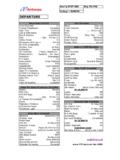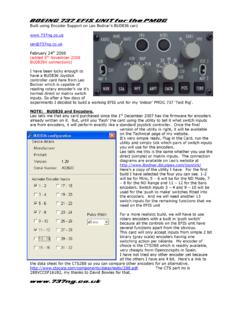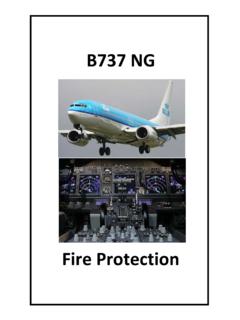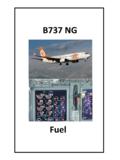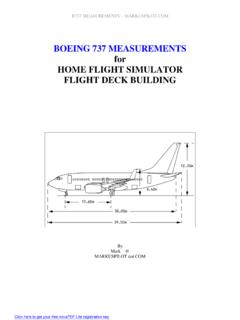Transcription of Building A Boeing 737 Yoke
1 Updated Dec 2008 Mk3 Yokeupdated Dec 2008 Mk3 Yokeupdated Dec 2008 Mk3 Yokeupdated Dec 2008 Mk3 yoke Building A Boeing 737 YokeBuilding A Boeing 737 YokeBuilding A Boeing 737 YokeBuilding A Boeing 737 yoke I will get two prototype yokes from CiM Flightdecks by Christmas, but a friend also expressed an interest in changing his CH Yokes for a more realistic alternative. Always being one to take up a challenge, I set about looking at possibilities. I m very lucky to have quite a enquiring mind and a workshop at home. So with pencil and paper in hand off I went. We needed to represent two motions of axis for the pitch and the roll and also have the capability of button presses to emulate the control inputs that are available on the original yoke .
2 Please bear in mind that this is a prototype to prove the concept and give you the general idea of how to build the yoke . It has been built from materials which I had in my workshop and not from specially purchased items. Ok some of the nuts and bolts are a bit big for what they need to do, but the end item works, it works very well and the design can be improved. In fact I already have drawings to make the yoke fit onto the CH Products Rudder Pedals. The original design used Springs for the resistance action, but springs are not accurate, they are noisy and it s difficult to get exact centering with them.
3 So the solution has been to use Gas Struts (Not expensive, about 30 from SGS in Derby). And the yoke you see will have a 465 x 500mm aluminium checker plate base (which I got from alum-droitwich off ebay cost 17). The outer casings are Grey Rain Pipe which is available from just about any Builders Merchant (cost per yoke about 5). I was lucky enough to have an old 1 lever CH Gameport yoke in the attic (nobody uses gameport anymore) which I have stripped for the control wheel (including the buttons). So the overall cost of making this has been less than 70. You may decide to get a real Boeing Control wheel.
4 I decided to try Roberto Soriano s Fibreglass Control Wheel. For the money it s very good, but needs a bit of work to get it operational. The yoke has been made in three A. Part 1. The top section which is the Control Wheel and the mechanism to drive the X axis potentiometer for the Ailerons. A Centre Section which is simply a hollow tube. This can be cut to length to give you correct height for your purpose, and Part 3. The Bottom Section which contains the mechanism to drive the Y axis pot for the elevators along with adjusters. It also contains the frame for the Gas Struts.
5 HERE s THE THREE PIECESHERE s THE THREE PIECESHERE s THE THREE PIECESHERE s THE THREE PIECES The Top Section (Part 1)The Top Section (Part 1)The Top Section (Part 1)The Top Section (Part 1) The Centre SectionThe Centre SectionThe Centre SectionThe Centre Section The Lower Section (Part 3)The Lower Section (Part 3)The Lower Section (Part 3)The Lower Section (Part 3) Here s a Basic rundown of how it all works below with a step by step description. This was the basic Idea which progressed to what you see below Part 1 ROLL (AILERON) ACTION Part 1 ROLL (AILERON) ACTION Part 1 ROLL (AILERON) ACTION Part 1 ROLL (AILERON) ACTION Take a look at the above illustration.
6 It s pretty simple if you study it. But basically, this is how it works. Shaft B rotates in two bushes in Frame C. On one end of the shaft is bolted plate A (this is what you fix your control wheel to). On the other end of the shaft is attached a toothed pulley (D). The pulley prevents the shaft from being pulled forward and I have attached two locknuts inside the rear top upright plate of frame C to stop the shaft from being pushed back. It then follows that if you rotate plate A, shaft B transmits that motion to Pulley D. A second pulley is attached to the potentiometer F which is fitted to the lower bracket on frame C.
7 The two pulleys are joined by a toothed belt which then transmits the rotational motion of upper pulley D to lower pulley D and consequently, the pot. In my prototype, I have also included an adjuster so I can get the drive belt to sit nice on the pulleys without any tension which may damage the potentiometer. That s how the Ailerons will be driven. Here s some photo s to give you a better idea. Part 2 RefinementsPart 2 RefinementsPart 2 RefinementsPart 2 Refinements Look at the above picture. See a nut is welded to the side plate and threaded rod is run thru the nut. OK it then follows that if you support a piece of threaded rod on both ends like this, then the nuts 1.
8 Act as a bearing allowing the threaded rod to rotate and 2. act as stop collars preventing the rod from moving backwards and forwards. Because none of the rotating parts in this yoke are under any kind of strain, this was an ideal solution for the column hinge point and the control wheel rotating shaft. So looking at the diagram in Part 1, what I did was weld two nuts on the inside of frame B and used 8mm threaded rod to join plate A and pulley D. The yoke is attached to the front end. Above is a picture of Roberto Soriano s yoke and below is a picture of the Boss I made to replace plate A in Part 1.
9 Now in order to get the yoke right upto the column, the nut you see welded to the plate will have to fit inside the yoke . Look again at the picture of the Control wheel and you will see a Grey area in the centre. I used a 32mm hole cutter to remove this piece from the front (it s going to be hidden by the Engravity Chart Plate). This allowed me access to the inside of the yoke to prepare my fixings and also to fit a locknut to secure the position of the control wheel on the shaft. The four smaller holes will allow me to use 4mm nuts and bolts to secure the boss to the Control wheel itself. The larger hole above the nut will carry the switch leads duly wrapped in PVC cable wrap to protect them.
10 Remembering that we are using a Fibreglass Moulded yoke here. Fibreglass is notoriously brittle and unforgiving to shock or stress before cracking or breaking. I built up the rear face of the yoke with epoxy filler to about 6mm thick to give it extra strength. I have also placed some 2mm rubber gaskets between the glassfibre and all metal items. It s all fitted together well and I m confident that it will now work without causing problems. Ok, that s got the top of the yoke working, lets move on to the bottom. The refinements to the bottom are further down. PART 3 PART 3 PART 3 PART 3 THE PITCH (ELEVATOR) ACTION THE PITCH (ELEVATOR) ACTION THE PITCH (ELEVATOR) ACTION THE PITCH (ELEVATOR) ACTION The Down Pipe A rocks on centre shaft B.
